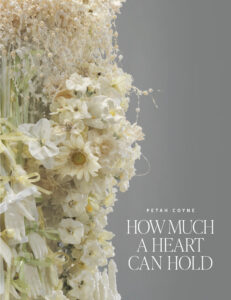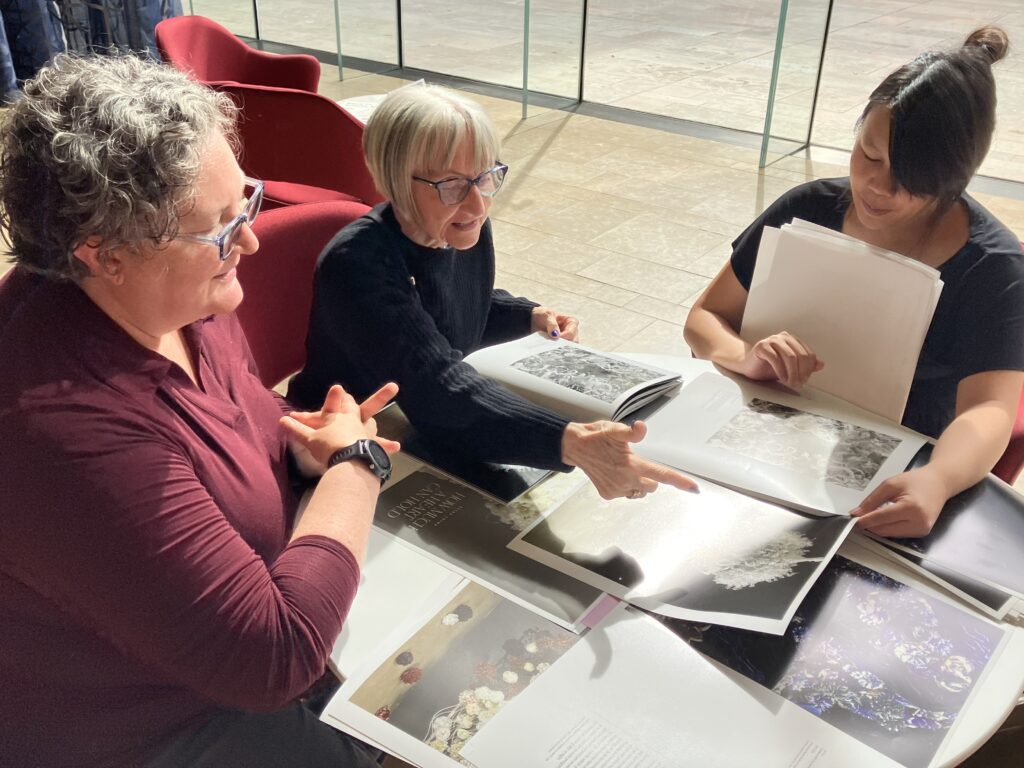
The exhibition catalogue is available in the Chazen Café.
Experience sprawling sculptural works made of cloth, human hair, scrap metal, wax, silk flowers and other unorthodox materials in Petah Coyne: How Much A Heart Can Hold, on view Sept. 9-Dec. 23 at the Chazen Museum of Art. The exhibition features more than a dozen works, several on display for the first time. It serves as both a multi-decade exploration of the contemporary American sculptor’s career and an ode to women’s complexity and creativity.
A quote by Zelda Fitzgerald inspired the exhibition title. “Nobody has ever measured, even the poets, how much a heart can hold,” the American writer, dancer and painter once said. Coyne’s Zelda, a sculpture named in Fitzgerald’s honor, anchors the exhibition.
“With her, I didn’t plan at all,” explained Coyne. “When I finished it and stood back and looked at it, I knew immediately that that was her.”
At nearly 7 feet tall, the mixed-media work from the Chazen’s collection is made of silk flowers, wax, acrylic paint, white pearl-headed hat pins, artificial pearls, cast-wax statuary figure and hand sculptures, ribbon, knitting needles, fabric, thread, wire, horsehair, drywall, plaster, filament, rubber, steel and wood. It immediately ignites the tactile senses, yet a transparent glass box stands between the viewer and the monochromatic work, representing a cage that is a metaphor for Fitzgerald’s life. Her accomplishments were thwarted by the time in which she lived and overshadowed by her marriage to F. Scott Fitzgerald. Many lines from her letters appear in her husband’s writings.
“I was making this piece after I’d read a lot of her things, and I started putting all these pearls on it. I realized later that I had cast maybe 60 or 70 hands and that these were maybe helping hands to [F. Scott Fitzgerald’s] writing,” Coyne explained.
Coyne reads two to three books per week. Most of them are by women writers. As she sews, she often imagines characters from different books in dialogue with one another. The exhibition’s three sections — “Women’s Work,” “Women Obscured and Transformed” and “Women’s Relationships” — present a view of Coyne’s artistic practice while honoring the literary contributors she loves.

From left: Chazen Director Amy Gilman, Petah Coyne, and designer Maria Tran review pages from the catalogue for the exhibition. The catalogue is available in the Chazen Café.
“We looked across Coyne’s long career and were inspired to focus on the creative work of women as interpreted through Coyne’s artistic process,” said Amy Gilman, director of the Chazen Museum of Art and exhibition curator. “Coyne looks at the woman as a heroine, cultural leader, dissident and activist and as a fellow creative who seeks to transform the deep aspects of consciousness and societal awareness.”
Coyne often celebrates under-recognized female authors and Eastern literary figures. Her works showcase the authors and characters; dissect their complex stories; and examine how relationships, social constructs and self-image can shape how women — real and fictional — experience and navigate the world.
Untitled #1379 (The Doctor’s Wife) (1997–2018) is among the works featured in How Much A Heart Can Hold. The installation of folded hand-sewn Venetian velvet in inky blues, blacks and teal carries the name of a novel by Sawako Ariyoshi. The renowned Japanese writer recalls the true story of Japanese surgeon Hanaoka Seishū and the competition between his wife and mother as they wrestled with their roles in the house and in late-18th-century Japan.
Untitled #720 (Eguchi’s Ghost) (1992/2007) is inspired by Yasunari Kawabata’s disturbing novel The House of the Sleeping Beauties that chronicles the experiences of older men who are allowed to sleep with and look at — but not touch — beautiful sleeping women, thereby evoking dreams of past loves. The sculpture hangs from the ceiling and is made from, among many other things, a 1950s Airstream trailer that has been shredded into thin stainless-steel wire. Coyne discovered the unique shredding process after asking a Yale University graduate student to take her to her favorite place. The student escorted Coyne to a facility that shreds and recycles the metals from cars, trucks, trains and other vehicles. Some of the other materials Coyne used in the artwork are PVC pipe, paper towels, silk Duchesse satin, thread, Velcro and shackles.
Coyne finds materials in various ways and tries to push them as far as she can. Over the years, they have ranged from the organic to the ephemeral including dead fish, mud, sticks, hay, black sand, satin ribbons and taxidermy. When the size of a work reaches more than 70 inches in one direction, her studio assistants put a tape measure on the floor. That’s her warning. “If I want to show the piece and not keep it for the rest of my life, then I better watch out,” she said. “I’m the person who makes the piece and then realizes it will have to go out the window.”
Coyne admits that pre-planning is not a part of her artistic process. While other artists start with mockups and drawings, she allows her feelings to guide her work. Although she has her own ideas about her finished works, she wants viewers to experience her art in the same way she approaches creating it — with an open heart. “I hope they open up their hearts and just look at the pieces,” she said. “It doesn’t matter what I feel about the work or what I made it for. If you just open yourself, you’ll feel something and that would be the most wonderful thing if they would do that.”
Coyne has been the subject of more than 30 solo museum exhibitions and her work is held in the permanent collections of the Museum of Modern Art (New York), Metropolitan Museum of Art (New York), Solomon R. Guggenheim Museum (New York), Whitney Museum of American Art (New York), San Francisco Museum of Modern Art (San Francisco), the Chazen and many others.
Earlier this year, Coyne received the Lifetime Achievement Award from the International Sculpture Center, and in November will be honored by the Kemper Museum of Contemporary Art. Additional awards include those from the John Simon Guggenheim Memorial Foundation, The Rockefeller Foundation, three from the National Endowment for the Arts, Pollock-Krasner Foundation, the Joan Mitchell Foundation, Asian Cultural Council, New York Foundation for the Arts, Anonymous Was A Woman, Augustus Saint-Gaudens Memorial Foundation, three from Artists Space, the Art Matters Award, two International Association of Art Critics Awards and the Southeastern Center for Contemporary Art Award in the Visual Arts.
Born in Oklahoma City in 1953, Coyne’s military family allowed her to delve deeply into other cultures through travel and study, with a particular interest in Japan and China. She currently lives in New York City.
The exhibition was curated by Amy Gilman, director of the Chazen Museum of Art at the University of Wisconsin–Madison. A catalogue was produced and will allow for a wide range of curriculum-inspired public programming and school engagement. Additionally, the exhibition will travel to the Lowe Art Museum at the University of Miami and the Neuberger Museum of Art at Purchase College, State University of New York.
Image: detail of Untitled #1378 (Zelda Fitzgerald), 1997-2013
Specially-formulated wax, pigment, silk flowers, candles, paint, white pearl-headed hat pins, ar3ficial pearl strands, cast-wax statuary figure, cast-wax hand sculptures, ribbon, knittng needles, steel rods, chicken-wire fencing, washers, fabric, thread, wire, horse hair, Masonite, plywood, drywall, plaster, glue, filament, rubber, steel, wood and metal screws, maple, laminated Luxar®, 81 3/16 x 35 3/4 x 35 3/4 in., Joen Greenwood Endowment Fund purchase, 2018.39a-b
Related Press
- Art Daily, Sep 22, 2025
- Grounds For Sculpture FEB 22, 2025
- "Bad at Sports" blog JAN 2, 2025
- Isthmus, DEC 8, 2024
- Art & Antiques Nov-Dec 2024
- Tone Madison, Nov 13, 2024
- The Isthmus, Nov 5, 2024
- Hyperallergic Oct 8, 2024
- Badger Herald, Sep 19, 2024
- The Isthmus, Sep 9, 2024
- Antiques and The Arts Weekly Sep 13, 2024, p. 9
- Wisconsin State Journal Aug 24, 2024
- ARTDAILY Aug 22, 2024
- Sculpture magazine
- Galerie Lelong
Programming & Financial Support
Petah Coyne: How Much A Heart Can Hold was made possible with support from the Anonymous Trust Fund and the Joen Greenwood Fund for the Chazen Museum of Art. Pamela and Steven Hootkin provided generous support for production of the exhibition catalogue.